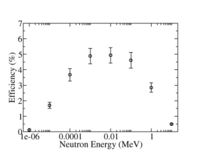Difference between revisions of "Forest He-3 Tubes"
Jump to navigation
Jump to search
| Line 1: | Line 1: | ||
| + | |||
| + | The neutron capture of He-3 may be represented by the reaction below | ||
| + | |||
| + | <math>n + He^3 \rightarrow p + H^3</math> | ||
| + | |||
| + | About 764 keV of energy is liberated in this nuclear reaction and distributed between the final products according to their masses. Because the proton is abotu a factor of 3 lighter that T | ||
| + | ritium (H^3) , it will have more kinetic energy by about a factor of 3 (about 573 keV). This liberated proton can ionize other He-3 atoms via the reaction | ||
| + | |||
| + | <math>p+He^3 \rightarrow p + He^3(+) + e^-</math> | ||
| + | |||
| + | |||
[[Image:He-3Tube_DetectorDrawing.jpg]] | [[Image:He-3Tube_DetectorDrawing.jpg]] | ||
[[Image:He-3Tube_PPND_Efficiency.jpg | 200 px]] | [[Image:He-3Tube_PPND_Efficiency.jpg | 200 px]] | ||
Revision as of 09:44, 6 June 2008
The neutron capture of He-3 may be represented by the reaction below
About 764 keV of energy is liberated in this nuclear reaction and distributed between the final products according to their masses. Because the proton is abotu a factor of 3 lighter that T ritium (H^3) , it will have more kinetic energy by about a factor of 3 (about 573 keV). This liberated proton can ionize other He-3 atoms via the reaction
